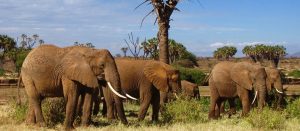
As I reflect on my first few days in camp, I am amazed at the amount of memorization undertaken by each of the individuals who work here throughout the year. Upon arrival, it was explained that I would be assisting with field work including long-term monitoring of elephants in Samburu National Reserve. Since 1997, the elephants have been regularly monitored, and given names and numbers as individual identifiers. In addition each family has a name. For example, in my first few days, I met the Royals, the Hardwoods, and the Spices. Each of these families are unique and exhibit a certain set of attributes that make them discernible from the others. Still, to remember them all would take some time, for sure. I would need to employ an elephant-like memory. This was the first task I set out for myself – learning these families.
To the untrained eye, most elephants would seem to look like any other elephant. However, to a skilled elephant scientist, these traits are immediately apparent. Some characteristics that are commonly used to identify elephants are presence or absence of tusks, as well as color and morphology of the tusks. Arapaho – a very distinguished lady of the American Indian family has only a right tusk that is long and slender and juts out to the side, rather than straight forward. Other markings that are commonly used to tell individuals apart are ear traits. The frayed edges, holes, slits, notches and cuts each provide a clue to the observer and mark the elephant’s story, like words on the pages of a memoir, of the long journeys they have traversed across the rugged, Acacia-speckled landscape.
In addition, when a family unit is observed a count is taken and location is noted. GPS location is of great importance so that we can see where the elephants are traveling during certain times of the day and certain parts of the year. Some of these elephants are resident populations, while others migrate in and out of the reserves. Their movement habits are also recorded (feeding, resting) as well as their reaction to the vehicle. For most of these elephants, they have become habituated to the STE cars over the years, and often many of them are especially curious about this large sand-colored specimen rolling by to observe them. In addition, the reserve does see its fair share of tourists, so the cars are nothing new for these elephants.
However, for elephants that do travel out of the reserves, they sometimes find themselves in places that are not safe. We recently encountered a female and her very young calf, likely born this year, accompanied by a young bull. It was explained that the young mother and bull were both probably orphans. Their reaction to the car was drastically different from the Hardwoods, with whom they were associating when we approached. These three elephants displayed some very typical alert behaviors: a raised tail and head, fully-opened ears, and a couple alert trumpets. They immediately retreated out into the bush and hid under a small stand of trees while we passed. For these elephants, the car signified something to fear. Perhaps a memory flashed. “Vehicle” meant something very bad could happen. We noted their reaction index, in contrast with the Hardwoods who were calm the entire time of our presence. For these three elephants, I can only guess at what they may have experienced to make them react this way. I can only hope that they will come to know and trust the STE staff and vehicles, and that I shall never see what they have seen… and that they shall never experience it again. An elephant never forgets.

